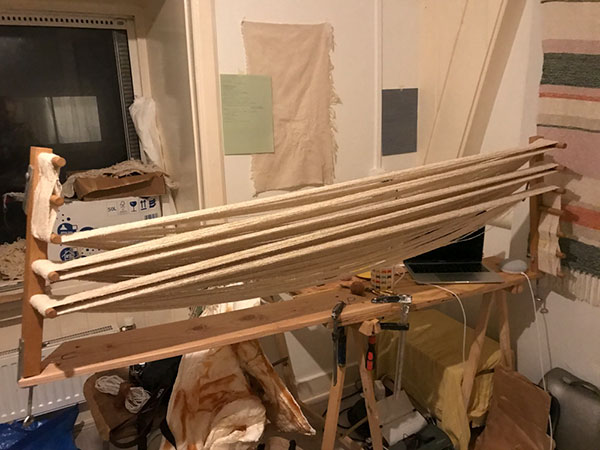Bronwen Jones is the founder of ‘Woven slow‘, a project born from a love of the slow nature of weaving. Here, she shares her thoughts on the slow weaving process and the place textiles have in our lives.
Images provided by Bronwen Jones & Sonia Perdeck for Kikubari
Weaving is a space for joining horizontal with vertical, for patching loose threads to make a whole. A slow act of care that reveals the hands of the maker throughout. The work of care becomes barely visible; our eyes are so used to seeing whole cloths, and buying new outfits to wrap around ourselves, we don’t see the time that slowly trickles into a piece made by hand; the many hours spent going back and forth, left to right, right to left, undoing mistakes, fixing the frames that enable us to create.
Many actions and processes go into a woven piece: washing, warping, threading, tying, weaving, combing, knotting, repairing… These acts of doing create a space for the mind to wander. . . a space for thinking and re-thinking. Musing on everyday life and the things that come into contact with our soft bodies. Thoughts on slow living, on how time slips by, chewing holes into clothes, rubbing against elbows and pointy toes. Time spreads through materials, telling stories through traces in fabric. The magical power of clothing to draw back sweet memories, to transport one to a hot summer day, or a rainy beach walk with family. A favourite scarf that wraps softly around the neck, carefully shielding the wind on a rocky cliff walk. The feeling of slouching inside an oversized jumper, one taken from the wardrobe of a papa, or grandma, or lover, and the comfort of feeling their warm sleeves wrapped around you, an endlessly warm embrace. The warmth of a far away loved one ― their smell encapsulated in the folds of fabric. The wardrobe becomes a collage of memories, encapsulating a life within material.
How special it is to layer stories and memories into objects, and how natural it is that they go into those objects closest to us; those that touch our bodies like a second skin, wrapped around us throughout the day, warming us and protecting us, covering us and expressing our values and desires. Is it not therefore important to be in touch with the stories and slow traditions that brought these objects into being? To patch together our own stories and memories with the life of the object before it came into our belonging.
A woven piece begins with singular yarns. First, the vertical threads (the warp) are prepared, they are measured out precisely, so that every warp thread is the exact same length, all spooling out of one singular yarn. An unending wave of yarn stretching back and forth for metres at a time. These warp threads are then fed into the loom, devoured up so that many metres of warp roll into the back end of the loom ― sitting, waiting to be woven. This step requires a spare pair of hands, two sets of hands lovingly preparing for the act of weaving. Each warp thread then must be individually threaded into the loom, so that when the time comes to weave, the threads may rise and fall to allow the horizontal thread (the weft) to pass over and under the warp. These actions require the maker’s hands to touch and care for every single thread that you see in a woven fabric: It is an act of love. It is an ode to slowing down. Each step can take hours of repetitive movements. The threads are then tied to the beginning beam, and the process may begin.
The warp threads ebb and flow, being lifted and let down, to allow the weft to pass back and forth horizontally, slowly weaving together warp and weft to create a singular cloth. Two prolonged yarns, the warp and weft, interlocking like two endless snakes wrapping around one another to become one. All the while the weaver feels each line that passes back and forth, feeling for the right tension, searching for a balance in colour and material, repairing when a single thread breaks. It becomes a dialogue between maker and material; the weaver listens and feels, using her senses to ensure that the cloth is growing well, similarly the weave listens and absorbs the feelings of the weaver. She thinks of wrappings that hug and comfort the soft body, she thinks of how weaving articulates something other than language, a material language that all bodies speak.
The slow time of crafting by hand creates a calm reflective space. Woven slow blossoms out of this space; soft cloths made to wrap around the body, slow sustainable processes made to rethink fast fashion and the temptation of constantly consuming new.
Woven slow believes in a slow way of consuming; making season-less garments that can be lived alongside, that age with us, and become softer and stretch more with time. Each piece is sustainable; made from dead-stock natural yarns, mostly silk, wool and cotton. The yarns are dead-stock industrial yarns that were collected when many weaving mills in the Netherlands closed between the 1970s and 90s. These yarns have remained in good condition but unused since then. Each piece is uniquely woven by hand to give lasting life to these leftovers, and made to be passed down generations.
Each piece is hand-woven on a table loom, from the same collection of yarns but with slight variations on each piece, the process is guided by careful selections of colour and material, resulting in playful contemplations. When taken off the loom, the weaves are slowly finished by hand, either by tying the ends or by individually weaving each thread back in. Every piece is made by one pair of hands, and therefore each carries unique details and imperfections.
Woven slow is oriented around bringing a slowness to everyday life and finding an awareness of what we wrap our soft bodies in. It wishes to rethink concepts of ageing and focus on the beauty of time passing; to invest care into fewer objects, and repair those that have wrinkled with time.












